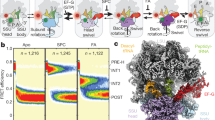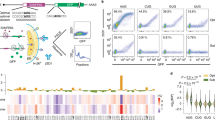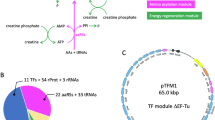Abstract
The translation of messenger RNA sequences into polypeptide sequences according to the genetic code is central to life. How this process, which relies on the ribosomal machinery, arose from much simpler precursors is unclear. Here, we demonstrate that single nucleotides charged with an amino acid couple with amino acids linked to the 5′-terminus of an RNA primer in reactions directed by the nucleotides of an RNA template in dilute aqueous solution at 0 °C. When a mixture of U-Val, A-Gly and G-Leu competed for coupling to Gly-RNA, base pairing dictated which dipeptide sequence formed preferentially. The resulting doubly anchored dipeptides can retain their link to the primer for further extension or can be fully released under mild acidic conditions. These results show that a single-nucleotide-based form of translation exists that requires no more than oligoribonucleotides and anchored amino acids.

This is a preview of subscription content, access via your institution
Access options
Access Nature and 54 other Nature Portfolio journals
Get Nature+, our best-value online-access subscription
$29.99 / 30 days
cancel any time
Subscribe to this journal
Receive 12 print issues and online access
$259.00 per year
only $21.58 per issue
Buy this article
- Purchase on Springer Link
- Instant access to full article PDF
Prices may be subject to local taxes which are calculated during checkout





Similar content being viewed by others
Data availability
The data generated and analysed during the current project are provided in this paper and its Supplementary Information. Supplementary data, materials and methods are presented in the Supplementary Information. Source data are provided with this paper.
References
Noller, H. F. Evolution of protein synthesis from an RNA world. Cold Spring Harb. Perspect. Biol. 4, a003681 (2012).
Crick, F. H. C., Brenner, S., Klug, A. & Pieczenik, G. A speculation on the origin of protein synthesis. Orig. Life 7, 389–397 (1976).
Morgens, D. W. The protein invasion: a broad review on the origin of the translational system. J. Mol. Evol. 77, 185–196 (2013).
Noller, H. F. RNA structure: reading the ribosome. Science 309, 1508–1514 (2005).
Gilbert, W. Origin of life: the RNA world. Nature 319, 618 (1986).
Di Giulio, M. On the RNA world evidence in favor of an early ribonucleopeptide world. J. Mol. Evol. 45, 571–578 (1997).
De Duve, C. The onset of selection. Nature 433, 581–582 (2005).
Berg, P. The chemical synthesis of amino acyl adenylates. J. Biol. Chem. 233, 608–611 (1958).
Orgel, L. E. The origin of polynucleotide-directed protein synthesis. J. Mol. Evol. 29, 465–474 (1998).
Paecht-Horowitz, M., Berger, J. & Katchalsky, A. Prebiotic synthesis of polypeptides by heterogeneous polycondensation of amino acid adenylates. Nature 228, 636–639 (1970).
Tamura, K. & Schimmel, P. Peptide synthesis with a template-like RNA guide and aminoacyl phosphate adaptors. Proc. Natl Acad. Sci. USA 100, 8666–8669 (2003).
Tamura, K. & Schimmel, P. Oligonucleotide-directed peptide synthesis in a ribosome- and ribozyme-free system. Proc. Natl. Acad. Sci. USA 98, 1393–1397 (2001).
Turk, R. M., Chumachenko, N. V. & Yarus, M. Multiple translational products from a five-nucleotide ribozyme. Proc. Natl Acad. Sci. USA 107, 4585–4589 (2010).
Turk, R. M., Illangasekare, M. & Yarus, M. Catalyzed and spontaneous reactions on ribozyme ribose. J. Am. Chem. Soc. 133, 6044–6050 (2011).
Pascal, R., Boiteau, L. & Commeyras, A. From the prebiotic synthesis of alpha-amino acids towards a primitive translation apparatus for the synthesis of peptides. Top. Curr. Chem. 259, 69–122 (2005).
Wolf, Y. I. & Koonin, E. V. On the origin of the translation system and the genetic code in the RNA world by means of natural selection, exaptation and subfunctionalization. Biol. Direct 2, 14 (2007).
Morris, K. N., Jensen, K. B., Julin, C. M., Weil, M. & Gold, L. High affinity ligands from in vitro selection: complex targets. Proc. Natl Acad. Sci. USA 95, 2902–2907 (1998).
Ellington, A. D. & Szostak, J. W. In vitro selection of RNA molecules that bind specific ligands. Nature 346, 818–822 (1990).
Xiao, H., Murakami, H., Suga, H. & Feree-D’Amare, A. R. Structural basis of specific tRNA aminoacylation by a small in vitro selected ribozyme. Nature 454, 358–361 (2008).
Yarus, M. The genetic code and RNA-amino acid affinities. Life 7, 13 (2017).
Jauker, M., Griesser, H. & Richert, C. Spontaneous formation of RNA strands, peptidyl RNA and cofactors. Angew. Chem. Int. Ed. 54, 14564–14569 (2015).
Griesser, H. et al. Ribonucleotides and RNA promote peptide chain growth. Angew. Chem. Int. Ed. 56, 1219–1223 (2017).
Cherepanov, A. V. & de Vries, S. Kinetic mechanism of the Mg2+-dependent nucleotidyl transfer catalyzed by T4 DNA and RNA ligases. J. Biol. Chem. 277, 1695–1704 (2002).
Griesser, H., Bechthold, M., Tremmel, P., Kervio, E. & Richert, C. Amino acid-specific, ribonucleotide-promoted peptide formation in the absence of enzymes. Angew. Chem. Int. Ed. 56, 1224–1228 (2017).
Jash, B. & Richert, C. Templates direct the sequence-specific anchoring of the C-terminus of peptido RNAs. Chem. Sci. 11, 3487–3494 (2020).
Huang, W. & Ferris, J. P. Synthesis of 35-40 mers of RNA oligomers from unblocked monomers. A simple approach to the RNA world. Chem. Commun. 2003, 1458–1459 (2003).
Gottikh, B. P., Krayevskyn, A. A., Tarussovap, B., Purygin, P. & Tsilevich, T. L. The general synthetic route to amino acid esters of nucleotides and nucleosides-5′-triphosphates and some properties of these compounds. Tetrahedron 26, 4419–4433 (1970).
Grosjean, H. & Westhof, E. An integrated, structure- and energy-based view of the genetic code. Nucleic Acids Res. 44, 8020–8040 (2016).
Englert, M. et al. Aminoacylation of tRNA 2′- or 3′-hydroxyl by phosphoseryl- and pyrrolysyl-tRNA synthetases. FEBS Lett. 587, 3360–3364 (2013).
Motsch, S., Tremmel, P. & Richert, C. Regioselective formation of RNA strands in the absence of magnesium ions. Nucleic Acid Res. 48, 1097–1107 (2020).
Sievers, D. & von Kiedrowski, G. Self-replication of complementary nucleotide-based oligonucleotides. Nature 369, 221–224 (1994).
Schimpl, A., Lemmon, R. M. & Calvin, M. Cyanamide formation under primitive earth conditions. Science 147, 149–150 (1965).
Liu, Z., Ajram, G., Rossi, J.-C. & Pascal, R. The chemical likelihood of ribonucleotide-α-amino acid copolymers as players for early stages of evolution. J. Mol. Evol. 87, 83–92 (2019).
Kervio, E., Hochgesand, A., Steiner, U. E. & Richert, C. Templating efficiency of naked DNA. Proc. Natl Acad. Sci. USA 107, 12074–12079 (2010).
Sarracino, D. & Richert, C. Quantitative MALDI-TOF spectrometry of oligonucleotides and a nuclease assay. Bioorg. Med. Chem. Lett. 6, 2543–2548 (1996).
Cornell, C. E. et al. Prebiotic amino acids bind to and stabilize prebiotic fatty acid membranes. Proc. Natl Acad. Sci. USA 116, 17239–17244 (2019).
Kervio, E., Sosson, M. & Richert, C. The effect of leaving groups on binding and reactivity in enzyme-free copying of DNA and RNA. Nucleic Acid Res. 44, 5504–5514 (2016).
Sosson, M., Pfeffer, D. & Richert, C. Enzyme-free ligation of dimers and trimers to RNA primers. Nucleic Acid Res. 47, 3836–3845 (2019).
Tetzlaff, C. N. & Richert, C. Synthesis and hydrolytic stability of 5′-aminoacylated oligouridylic acids. Tetrahedron Lett. 42, 5681–5684 (2001).
Jovanovic, D., Tremmel, P., Pallan, P. S., Egli, M. & Richert, C. The enzyme-free release of nucleotides from phosphoramidates depends strongly on the amino acid. Angew. Chem. Int. Ed. 59, 20154–20160 (2020).
Yi, R., Hongo, Y. & Fahrenbach, A. C. Synthesis of imidazole-activated ribonucleotides using cyanogen chloride. Chem. Commun. 54, 511–514 (2018).
Acknowledgements
We thank D. Pfeffer for help with high-performance liquid chromatography, H. Griesser for reading and commenting on a draft of the manuscript, E. Kervio and S. Lorenz for discussions, D. Göhringer for technical assistance and C. Guttroff for measuring ESI mass spectra. This work was funded by Deutsche Forschungsgemeinschaft (project-ID 364653263-TRR 235) and the Volkswagen Foundation (grant no. Az 92 768) (to C.R.).
Author information
Authors and Affiliations
Contributions
B.J., P.T. and D.J. performed the experiments, C.R. devised and supervised the project. All authors analysed the data. All authors wrote the manuscript and all authors reviewed and commented on the manuscript.
Corresponding author
Ethics declarations
Competing interests
The authors declare no competing interests.
Additional information
Peer review information Nature Chemistry thanks Thomas Carell and the other, anonymous, reviewer(s) for their contribution to the peer review of this work.
Publisher’s note Springer Nature remains neutral with regard to jurisdictional claims in published maps and institutional affiliations.
Supplementary information
Supplementary Information
Materials and methods, general protocols for synthesis, analytical data, Figs. 1–68 and Tables 1–6.
Source data
Source Data Fig. 2
Source data for Fig. 2c.
Source Data Fig. 3
Source data for Fig. 3b.
Source Data Fig. 5
Source data for Fig. 5.
Rights and permissions
About this article
Cite this article
Jash, B., Tremmel, P., Jovanovic, D. et al. Single nucleotide translation without ribosomes. Nat. Chem. 13, 751–757 (2021). https://doi.org/10.1038/s41557-021-00749-4
Received:
Accepted:
Published:
Issue Date:
DOI: https://doi.org/10.1038/s41557-021-00749-4
This article is cited by
-
Heat flows enrich prebiotic building blocks and enhance their reactivity
Nature (2024)
-
A prebiotically plausible scenario of an RNA–peptide world
Nature (2022)
-
A possible path towards encoded protein synthesis on ancient Earth
Nature (2022)
-
The origin of translation
Nature Chemistry (2021)



